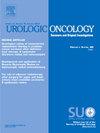EVALUATION OF RESPONSE TO 177LU-PSMA-617 BY SITE SPECIFIC DISEASE IN METASTATIC CASTRATE-RESISTANT PROSTATE CANCER
IF 2.4
3区 医学
Q3 ONCOLOGY
Urologic Oncology-seminars and Original Investigations
Pub Date : 2025-03-01
DOI:10.1016/j.urolonc.2024.12.070
引用次数: 0
Abstract
Introduction
In 2022, the FDA approved 177Lu-PSMA as a promising drug for metastatic castrate-resistant prostate cancer (mCRPC) after the VISION trial. Since then, multiple studies have tried to evaluate the response to 177Lu-PSMA; however, few studies have described the response depending on the site of disease progression. In our study, we aim to assess the response to 177Lu-PSMA according to the metastasis sites.
Methods
We queried retrospectively 273 patients who have been treated with 177Lu-PSMA at Mayo Clinic between April 2022 and September 2023; out of those, we identified 76 (28%) patients who presented with either bone only or lymph node (LN) only disease. Trained research personnel recorded clinicopathological variables; in addition, follow-up imaging and clinical documentation were used to record the treatment outcomes. Chi-square and Kruskal-Wallis tests were used to compare between nominal and continuous variables, respectively.
Results
After the identification of 76 patients, we classified them into two groups according to the site of disease progression: pure bone disease (52 patients, 68%) and pure lymph node disease (24 patients, 32%) without any other sites of disease progression, and both had the same volume of disease. The bone group had a high median initial Gleason score (p=0.0192) and PSA levels (p=0.158) prior to the start of the 177Lu-PSMA cycles compared with the LN group. With a median follow-up time of 10.2 (IQR: 8.6–11.5) months from the first 177Lu-PSMA cycle, the post-treatment PSA kinetics did not differ significantly between the two groups; however, patients with LN disease showed a durable response in terms of decreased post-treatment SUVmax of the lesions (p=0.0299) and less radiographic disease progression (p=0.0011) compared with the bone group.
Conclusions
With the limited options for mCRPC patients after receiving several lines of treatment, the 177Lu-PSMA offers an excellent alternative according to the VISION trial; however, the evaluation of its effect in real-world data is still under investigation. In our study, we found that patients who were treated with 177Lu-PSMA and had LN only disease showed a durable response compared with those with bone only disease. Further prospective studies to validate our findings are warranted.
求助全文
约1分钟内获得全文
求助全文
来源期刊
CiteScore
4.80
自引率
3.70%
发文量
297
审稿时长
7.6 weeks
期刊介绍:
Urologic Oncology: Seminars and Original Investigations is the official journal of the Society of Urologic Oncology. The journal publishes practical, timely, and relevant clinical and basic science research articles which address any aspect of urologic oncology. Each issue comprises original research, news and topics, survey articles providing short commentaries on other important articles in the urologic oncology literature, and reviews including an in-depth Seminar examining a specific clinical dilemma. The journal periodically publishes supplement issues devoted to areas of current interest to the urologic oncology community. Articles published are of interest to researchers and the clinicians involved in the practice of urologic oncology including urologists, oncologists, and radiologists.

 求助内容:
求助内容: 应助结果提醒方式:
应助结果提醒方式:


